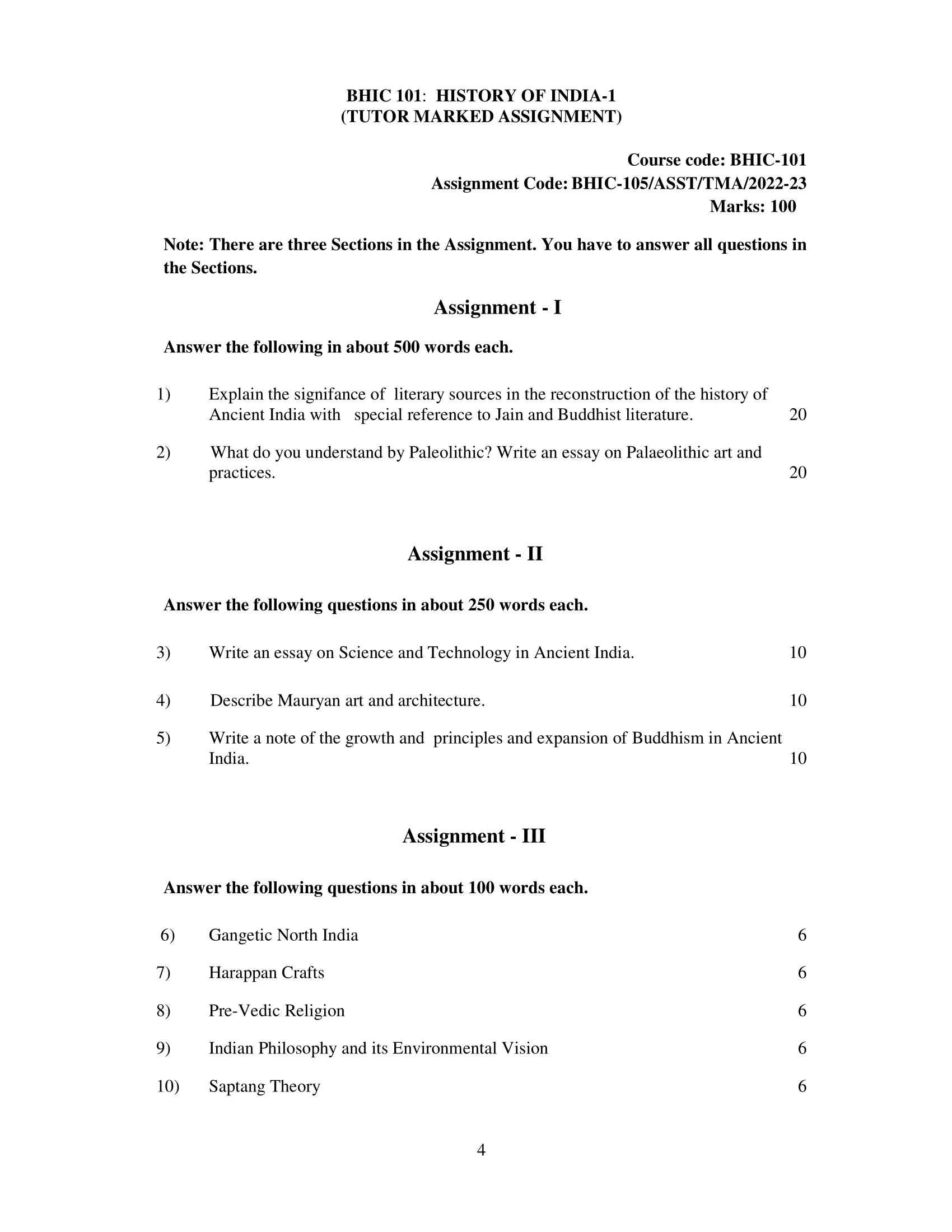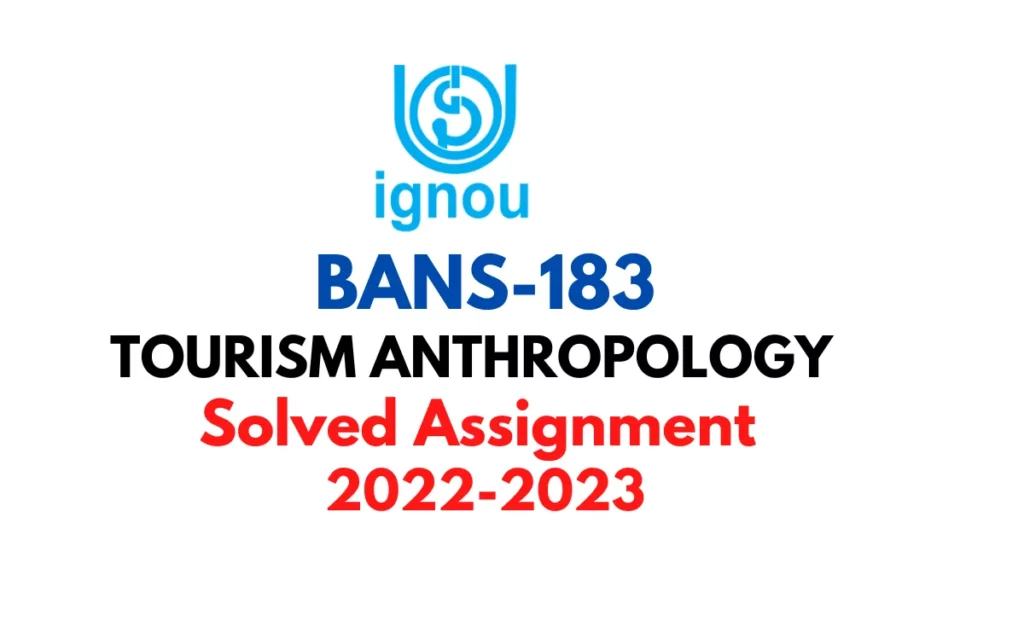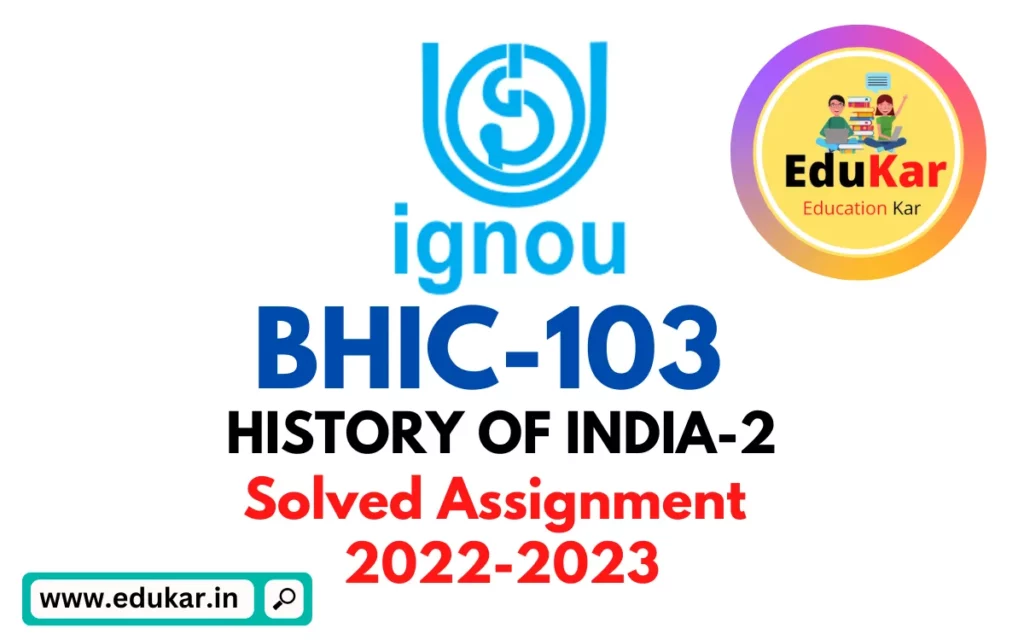Contents
- 1 Assignment – I
- 2 Answer the following in about 500 words each.
- 3 1) Explain the signifance of literary sources in the reconstruction of the history of Ancient India with special reference to Jain and Buddhist literature.
- 4 2) What do you understand by Paleolithic? Write an essay on Palaeolithic art andpractices.
- 5 Assignment – II
- 6 Answer the following questions in about 250 words each.
- 7 3) Write an essay on Science and Technology in Ancient India.
- 8 4) Describe Mauryan art and architecture.
- 9 5) Write a note of the growth and principles and expansion of Buddhism in Ancient India.
- 10 Assignment – III
- 11 Answer the following questions in about 100 words each.
- 12 6) Gangetic North India
- 13 7) Harappan Crafts
- 14 8) Pre-Vedic Religion
- 15 9) Indian Philosophy and its Environmental Vision
- 16 10) Saptang Theory

| Title | BHIC-101: IGNOU BAG Solved Assignment 2022-2023 |
| University | IGNOU |
| Degree | Bachelor Degree Programme |
| Course Code | BHIC-101 |
| Course Name | HISTORY OF INDIA-1 |
| Programme Name | Bachelor of Arts (General) |
| Programme Code | BAG |
| Total Marks | 100 |
| Year | 2022-2023 |
| Language | English |
| Assignment Code | BHIC-105/ASST/TMA/2022-23 |
| Last Date for Submission of Assignment: | For June Examination: 31st April For December Examination: 30th September |

Assignment – I
Answer the following in about 500 words each.
1) Explain the signifance of literary sources in the reconstruction of the history of Ancient India with special reference to Jain and Buddhist literature.
Ans: Literary sources, such as religious texts and other written records, are essential in the reconstruction of the history of ancient India. Jain and Buddhist literature, in particular, provide valuable insights into the social, economic, and cultural aspects of ancient Indian society. These religious texts and other literature were produced during the time when Jainism and Buddhism were flourishing in India, and they offer a wealth of information about the beliefs, practices, and values of the time.
One of the key significance of Jain literature is that it provides valuable information about the development of Jainism as a religious and philosophical tradition. Jain texts, such as the Jain Agamas, provide an in-depth understanding of Jain cosmology, ethics, and spirituality, as well as the history of Jainism as a religious community. Similarly, Buddhist literature, including the Buddhist Canon (Tripitaka), provides a wealth of information about Buddhist philosophy, teachings, and practices. These texts also provide insights into the cultural, economic, and political context of ancient India and how Buddhism was spread and adopted across the subcontinent.
In addition to religious texts, other literary sources, such as inscriptions, biographies, and historical accounts, also offer valuable information about ancient Indian history. For example, the inscriptions on the pillars of Ashoka, the famous Mauryan emperor, provide a wealth of information about his reign and the expansion of Buddhism during his rule. Biographies, such as the “Lives of the 63 Hagiographic Heroes,” offer insights into the lives and religious practices of early Buddhist figures. Finally, historical accounts, such as the “Mahavamsa” and the “Ramayana,” provide rich narratives about the political and social histories of ancient India.
2) What do you understand by Paleolithic? Write an essay on Palaeolithic art and
practices.
Ans:
Assignment – II
Answer the following questions in about 250 words each.
3) Write an essay on Science and Technology in Ancient India.
Ans: Science and technology in ancient India made remarkable contributions to the fields of mathematics, astronomy, surgery, and metallurgy. India’s history of science and technology dates back to thousands of years, and several discoveries and innovations were made during the ancient period.
Mathematics in ancient India was advanced and the concept of zero was developed by Indian mathematicians. The famous mathematician, Aryabhata, made significant contributions in the field of mathematics and astronomy. He was the first to calculate the value of pi and also developed a lunar calendar.
In the field of surgery, ancient Indian surgeons performed complex surgeries, including cataract surgery and plastic surgery. The medical text, Sushruta Samhita, written by the ancient Indian surgeon Sushruta, described various surgical procedures and the use of herbal medicines.
Metallurgy was also advanced in ancient India, and the use of iron was widespread. The iron pillar in Delhi, which dates back to the 4th century CE, is an example of the high level of metallurgical knowledge in ancient India.
In addition, ancient India made significant contributions to the field of astronomy. The ancient Indian astronomer, Varahamihira, wrote the text “Brihat Samhita,” which described astronomical calculations and predictions. The text also mentions the use of astronomical instruments such as the clepsydra and the water clock.
4) Describe Mauryan art and architecture.
Ans: The Mauryan Empire, which existed in ancient India from 321 to 185 BCE, was a time of great artistic and architectural achievements. The Mauryan period saw the development of various forms of art, such as sculpture, architecture, and coin design.
Mauryan architecture was characterized by the use of brick and stone to construct monumental structures, such as palaces, forts, and gates. One of the most famous examples of Mauryan architecture is the Great Stupa at Sanchi, which was built to commemorate the life of the Buddha. The stupa is a massive dome-shaped structure that was built of brick and stone and covered with intricate carvings.
Mauryan sculpture was characterized by the use of stone and the depiction of religious and mythological themes. Some of the most famous examples of Mauryan sculpture include the sculptures at the Great Stupa at Sanchi, the Yakshi figurines, and the Ashoka Pillar at Sarnath. These sculptures are known for their grace and realism, and they reveal the high level of skill and technical mastery of Mauryan sculptors.
Coin design was also an important aspect of Mauryan art. The Mauryan emperors issued a large number of coins that were struck in gold, silver, and copper. These coins were adorned with images of the emperor, Hindu gods, and animals. They also had inscriptions in ancient Indian script, providing valuable information about the political, cultural, and religious aspects of the Mauryan Empire.
5) Write a note of the growth and principles and expansion of Buddhism in Ancient India.
Ans: Buddhism is a religion that was founded in ancient India by Siddhartha Gautama, also known as the Buddha, in the 5th century BCE. The religion is based on the teachings of the Buddha, who emphasized the importance of ending suffering and achieving enlightenment.
In the early years of Buddhism, the religion was confined to the region of northeast India, where the Buddha lived and taught. However, as Buddhism spread throughout India, it attracted a large following and became a major religion. This growth was facilitated by the support of emperor Ashoka, who converted to Buddhism and used his vast empire to spread the religion throughout India and beyond.
Buddhism spread to neighboring countries such as Sri Lanka, Myanmar, and Thailand through the efforts of Buddhist monks and missionaries. The religion also spread to Central Asia, China, and Japan through trade and cultural exchange.
The principles of Buddhism include the Four Noble Truths and the Eightfold Path. The Four Noble Truths are that suffering exists, suffering arises from craving and attachment, suffering can be overcome, and the path to the end of suffering is the Eightfold Path. The Eightfold Path is a set of principles that guide individuals on their path to enlightenment, including right understanding, right intention, right speech, right action, right livelihood, right effort, right mindfulness, and right concentration.
Assignment – III
Answer the following questions in about 100 words each.
6) Gangetic North India
Ans: Gangetic North India refers to the northern region of India, which is located along the banks of the Ganges River. This region is considered one of the most fertile and densely populated areas in India and has played an important role in the country’s history and culture. The cities of Delhi, Varanasi, and Allahabad are located in this region and are considered major cultural, religious, and political centers. The region is also known for its rich history and heritage, including the Mughal Empire, which left a lasting impact on the region’s architecture, art, and culture. The fertile land of the Gangetic plain has long been used for agriculture, and the region remains an important center of agriculture in India today.
7) Harappan Crafts
Ans: Harappan crafts refer to the artistic and technological advancements of the Harappan Civilization, which existed in ancient India from 2600 to 1900 BCE. This civilization was known for its sophisticated urban planning, impressive architectural structures, and intricate crafts. Harappan crafts include pottery, metalwork, weaving, and jewelry making. The pottery was characterized by its fine craftsmanship, with delicate designs and intricate patterns. Metalwork was used to create tools, weapons, and jewelry, while weaving was used to produce textiles and clothing. Harappan jewelry was particularly impressive, with intricate designs and fine workmanship that showcased the skill of the Harappan artisans. These crafts not only reflect the level of technological advancement of the Harappan Civilization but also provide a glimpse into the daily life and cultural values of this ancient civilization.
8) Pre-Vedic Religion
Ans: Pre-Vedic religion in India refers to the religious beliefs and practices that existed prior to the Vedic period (ca. 1700-1100 BCE). It was a polytheistic religion that worshipped various gods and goddesses, such as the Mother Goddess, and performed rituals such as animal sacrifices. Pre-Vedic religion also believed in reincarnation and the cyclical nature of existence. The main evidence of pre-Vedic religion comes from archaeological sites, such as the Indus Valley Civilization, and later Vedic texts, which incorporated some elements of pre-Vedic beliefs into Hinduism.
9) Indian Philosophy and its Environmental Vision
Ans: Indian philosophy has a rich tradition of environmental thought and vision. From the ancient scriptures like the Vedas to the classical philosophical systems like Samkhya and Yoga, there is a deep understanding of the interconnectedness of all beings and the environment. The concept of ahimsa (non-violence) is central to many philosophical systems and extends to all living beings and nature. The idea of preserving balance and harmony in nature is seen as essential for the well-being of humanity. The Bhagavad Gita highlights the importance of performing one’s duty without attachment to the outcome, as a means of balancing the natural order. The environmental vision of Indian philosophy emphasizes the need for sustainability, compassion, and responsible use of resources.
10) Saptang Theory
Ans: Do it by yourself.
How to Download BHIC-101 Solved Assignment?
You can download it from the www.edukar.in, they have a big database for all the IGNOU solved assignments.
Is the BHIC-101 Solved Assignment Free?
Yes this is absolutely free to download the solved assignment from www.edukar.in
What is the last submission date for BHIC-101 Solved Assignment?
For June Examination: 31st April, For December Examination: 30th October
















